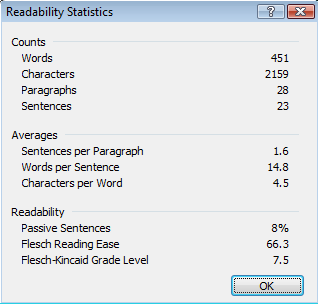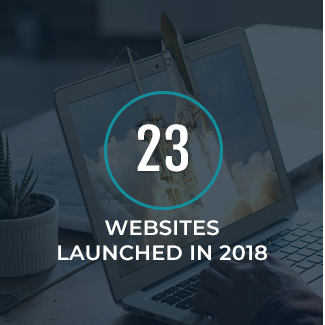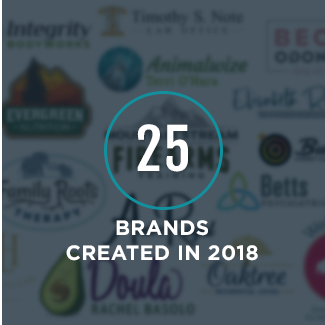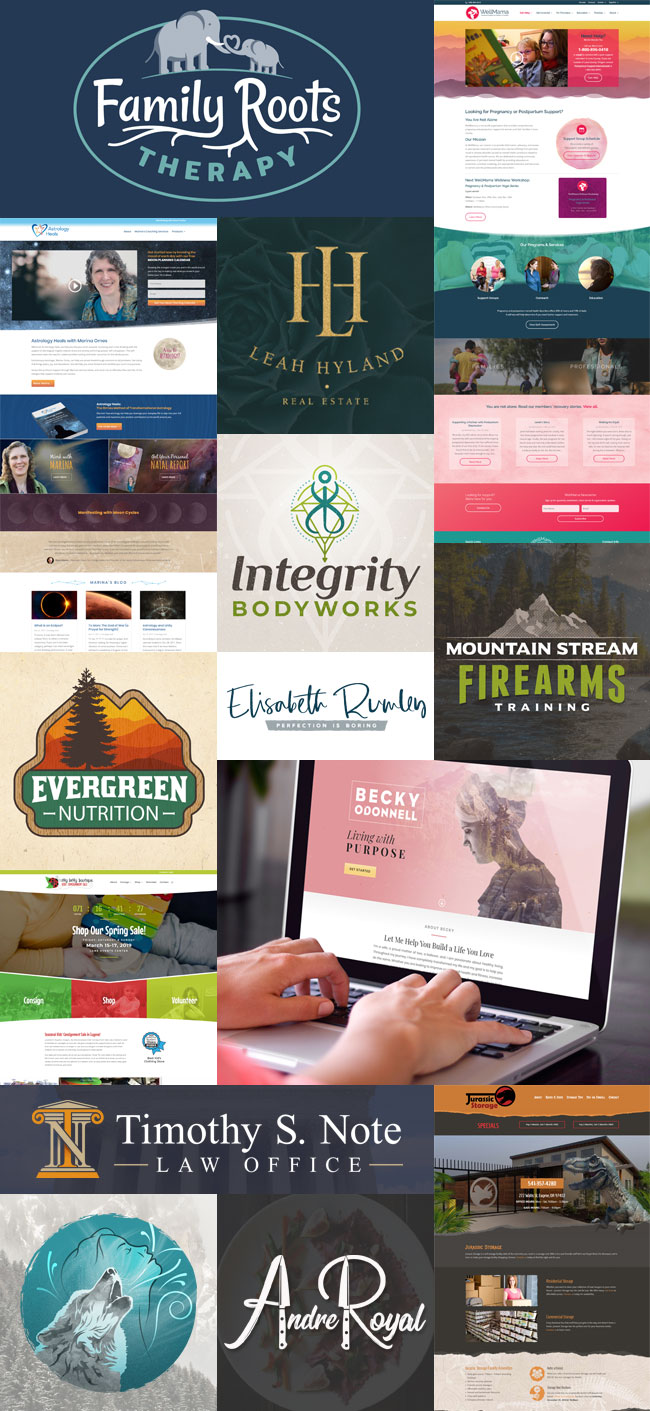
by Administrator | Apr 26, 2019 | Content Creation
Search Engine Optimization – or the art of getting your website’s content to rank well – is a complex and misunderstood practice. Many variables make up the algorithm that determines how your content will rank against your competitors. However, one variable that is becoming more and more important is the readability, or reading level, of the content. How this is rated is by using the Flesch Reading Ease formula. Let’s dive into that a bit more.
Why is readability important to Google and other search engines? Because they want to deliver relevant content to their users AND they also want to provide interesting and engaging content that the user will want to read. If the user can’t read the content or finds it to be too hard to read, they will likely leave your site. Google doesn’t like this.
So how do you know if your content is readable? One useful tool used throughout our industry, and that we use to help our clients get better rankings is a test known as Flesch Reading Ease.
What is the Flesch Reading Ease?
Also known as the Flesch-Kincade Reading Level, this digital test uses English language structures, word count, syllable count, and average sentence length to determine how difficult content is to read. The original concept was created by Rudolf Flesch.
In 1975, in partnership with J. Peter Kincaid, Flesch developed a formula to test the complexity of written materials. That test was then implemented by the United States Navy to evaluate the reading level of technical manuals used in training service members. A few years later, other branches of service began using the Flesch-Kincaid Readability Formula as well.
How is the Flesch Reading Score Calculated?
Each piece of content has a score. The higher the score, the easier the content is to read. Short sentences and small words are scored higher on the scale than long sentences and long words. Here’s how to scores break down:
- 0-30 are considered college level and are more suited to academia.
- 60-70 are considered 8th to 9th-grade reading level.
- 100 indicates a 1st to 2nd-grade reading level.
Many numbers floating around, depending on where you look, but the overall census is that most people are at the 8th-grade reading level. Since Google wants as many people as possible to be able to read and understand the page or article they rank, the content needs to be at or near an 8th-grade reading level. While this sounds easy enough, we find that we often have to simplify content we naturally write.
Increasing Your Readability Score
By paying attention to certain factors, your content can shift from a massive and hard-to-read wall of content into an easily consumable source of valuable information.
Shorten Your Paragraphs
Shorter paragraphs visually break up the content and allow your reader’s mind to digest the information in smaller chunks. It’s easier to process content while scrolling if it’s broken down. Bullet and numbered lists are your friend! How do you eat an elephant? One bite at a time.
Choose Fewer Words With More Power
When writing, use a more active voice. In other words, keep your reader’s attention by writing more directly. For instance, instead of saying, “The woman was advised by her doctor. ” say instead, “The doctor gave her advice.”
Also, avoid using excess words. For instance, you don’t need to say “a long marathon.” The word “marathon” already assumes it is “long”. Often, to get to a specific word count, you might be tempted to switch to passive voice or add “fluff,” but this will hurt your readability.
Write As You Talk – Not Like You Were Taught
When we talk to people in person, we have natural pauses and sentence stops. Also, we start sentences with “but” and “and” and “however” and other transition words. When we were in language arts classes, we were taught not to use these words at the beginning of a sentence, but in writing for the web, these words, as well as short sentences, make for easier reading.
Simplify Your Vocabulary
No one likes to feel upstaged, and not everyone is a walking thesaurus. There’s no need for “fancy talk” on a website. Use the simplest word to convey the same meaning — for instance, use “deep” instead of “profound.”
Additional Tips for Writing Blogs

Website content (often called website copy) is a different ballgame than the content for a blog. Here are a couple of tips to help you keep your blog full of good information and remain easy to read.
Focus
There are so many tangents that a blog can go on, but barraging a reader with a ton of different topics is only going to confuse. Find a focus topic, and elaborate on that one concept. Save the tangents for another post, and link to other related posts later.
Keywords
Google and other search engines use keywords for searching content to bring pages to the eyes of the reader. The keyword should always be in the first paragraph of the blog, in at least one header, and within 2-3% of the content. That means the keyword shouldn’t just be thrown around but used very strategically and intentionally. If your content has too many key phrases, you’ll struggle to stay on top of searches because Google hates what we call, “keyword stuffing.” Make sure it’s natural and don’t overdo it.
Consider Your Target Audience
Your blog will be easier to read and hold more attention if you follow the concepts of the Flesch Reading Ease score system, but it’s not the “be-all-end-all” of website copy or blog writing. Always consider your audience along with your readability score.
The Flesch Reading Ease is a guide, and it’s essential to follow your brand voice in your content. If you cater to a higher education level, then you can adjust your content to reflect that. We work hard to learn your business voice and your audience and write content that suits their needs.
Building website content can be overwhelming, and that’s okay. If you have any concerns about content, give us a call. We’ll put our team of Spyders on the job to make sure you see the results you’re looking for.
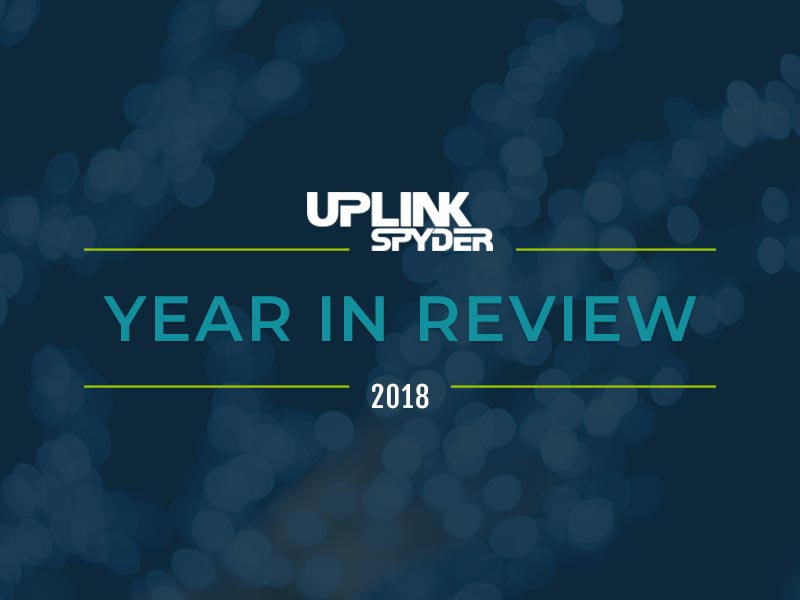
by Administrator | Jan 3, 2019 | Branding, Content Creation, Website Design
2018 was a busy year for us – and an exciting one at that. We’ve introduced new Spyders to our team, renovated and expanded our work-space (our “web”, if you will), added more businesses to our already awesome list of clients, and spent many hours doing what Spyders do best: writing, designing, and marketing.
To celebrate this incredible year, we have compiled a list of some of our favorite 2018 projects for your viewing pleasure. But first, a word from our fearless leader and CEO:
Our ten year anniversary as a company is this year — April 2019 — and it’s pretty remarkable to take a look at how far we’ve come and how much has transpired in those ten years. We started out of a home office with two clients.
When I look back, I see the huge mistakes we’ve made and tried our best to learn from and I see a landscape of beautiful and impactful work — but most of all, I see the relationships we’ve built over the years and continue to build. That’s why we do this work. Because we love to serve others and help other businesses grow and have successes of their own.
I want to take this moment to say thank you to all of you who have trusted UplinkSpyder — and the Spyders that work here — with your website, design, marketing and content needs. We have big plans for the next year. I’m really excited. I never thought of myself as a business owner, much less a successful one, but God has graced Emmanuel and myself with many extra chances to learn and grow. Employing others is one of the hardest and most rewarding experiences of our lives and I’m so very grateful I continue to have that opportunity.
Please take a look at a very small sample and a few cool statistics from the last year of our first decade. And stay tuned for more awesome to come…
Happy New Year!
Deanna Rivera, CEO
13,506+
Hours Creating Awesome
In 2018, our Spyders spent over 13,500 combined hours working on your website, blogs, social media, newsletters, and more – and guess what? We loved every minute of it. We find joy in creating a website with a beautiful, mobile-responsive design that wows both your customers and search engines. When we see your keyword rankings improving, or a Facebook ad generating tons of clicks to your website, we literally high-five each other for a job well done. Your success is our success.
183,000+
Words Written *Since June
Just over the last 7 months, we’ve written over 183,000 words to help increase website traffic and pull customers in based on careful SEO research. This is done through your website’s “normal” content outlining your services, but also through our new content marketing packages for blogging, which…not to toot our own horn or anything…are pretty freaking great. We can’t stress how important it is to regularly post blogs to your website. Don’t think your business needs a blog? We’d love to tell you why that’s not the case.
439+
Newsletters Sent
Over this past year, we have sent over 430 newsletters for our clients, and that doesn’t count the additional efforts we make to ensure each of those newsletters get opened and clicked on. This includes automated emails (triggered by contact forms, pop-ups, etc.) and newsletter re-sends, with new subject lines, to people that didn’t open them originally. With email marketing, and all of your marketing efforts, consistency is key! We help our clients stay in their customers’ inboxes through well-crafted newsletters, helping grow their audience along the way.
+53%
Average Website Growth as Compared to 2017
Our existing websites, that we maintain and update regularly, experienced an average of 50% growth, compared to 2017. That’s because we don’t just launch a website and then wave good-bye. We become business partners with our clients, constantly helping them discover new ways to grow their business. When you work with UplinkSpyder, you work with a team of individuals that become your friends, and treat your business like our own.
23 Websites Launched
2018 was the year of experimenting with new design methods, further content analysis, and improved user experience. Through all of the 23 websites we built and launched in 2018, we were able to create something unique, which we are very proud of. Your website is the heart of all your marketing, so if it doesn’t truly reflect your business, has false information, or doesn’t show up properly on a mobile device, it’s not benefiting you at all. In fact, it may be hurting you. Luckily, we happen to know a group of talented Spyders (not the creepy, crawly kind) that can fix these issues for you.
25 Brands Created
When a new business owner comes to us and says “I don’t have a logo yet,” or “I don’t have a brand yet,” – it’s music to our ears. Our favorite projects are the ones that we help you shape from the beginning. In 2018, we helped 25 businesses find their identity. Check out some of the highlights below.
Thanks for reading all of that,
but the proof is in the pudding.
Check out a few highlights from our web design and branding of 2018:

by Deanna Rivera | Jun 5, 2015 | Content Creation
“I hate to write.”
“I’m not a good writer.”
“I don’t have time to write.”
Is this you? If so, then let me ask you this:
Could you use more website traffic? (Google still thinks content is king.)
Once there, would you like people to find something interesting and learn more about you?
In summary, would you like your business to grow?
If you answered “Yes!”, then suck it up and write anyway.
Writing is really important to online marketing success.
However, I don’t want you to walk away feeling frustrated, so let me give you a few pointers and tips for how to get over the hurdle and begin writing.
First, the What.
Your content does not have to be a book. A piece of content can be “Google ready” if it is 100 words long. You can write 100 words. This paragraph is practically 100 words.
Your content does not need to be epic. The goal is not to get 1 million hits. The goal is to allow your potential customer to get to know you before they commit to buying you or even visiting you. It’s about your brand: the total package of who you are and why what you offer is worth a shot.
Start by brainstorming ideas of what to write. Examples can include:
- Projects you worked on and why they were amazing (before/after)
- People/organizations you helped and how/why/when you helped them (case studies)
- Products/experiences/companies/information you find useful that relate to your business
- Experiences you’ve had that others might learn from
- Lists of stuff that is relevant to your business – for whatever reason, people love lists
- Events/news the average user of your business would find interesting written in your words (including why you find them interesting) with links to the source
- Lessons you have to share (like what I’m doing right now)
I also love it when businesses use content to improve their business. Ask your readers to give input about how you can grow your business.
“But I still stink at writing!”
OK, fine. If you just cannot write, talk. Get a voice recorder (your phone likely has one) and tell a story. Then have someone on your staff, your spouse, or your child transcribe the story. Edit. Voila.
Or Why Not Video?
Video is really the best content you can create and it does not have to be professional if you are just starting out. Get a camera. Point it at yourself. Or record yourself doing what you do. When you publish it, I would also transcribe it.
“But…some other reason I can’t write or talk or video”
Well, guess what? We love to write. We love to write about you and what you do. It’s our thing. Our sole existence in the world is to promote your business…to get to know you as if we were you and represent you. We do our thing, you do your thing, we both grow, win win.
We have written good content for just about every kind of business there is. Think of us as journalistic marketers.
And then there’s the How.
Now that you have content, what do you do with it?
I use a word at UplinkSpyder a lot: disseminate. I am pretty sure my staff hate that word.
It means to spread. Widely. Facebook about it. Tweet it. Take a photo, and pin or Instagram it. YouTube or Vimeo something related to it. Email people with it. Link it on LinkedIn. Send your physical customers to it and ask them for feedback. Ask all your employees to read it. Tell everyone you know about it.
Seriously. Pretend you just wrote that book you thought you’d have to write and the world will now know you crossed something off your bucket list.
And now do it again. And again. Don’t stop. That’s how the magic happens. *insert sparkles*
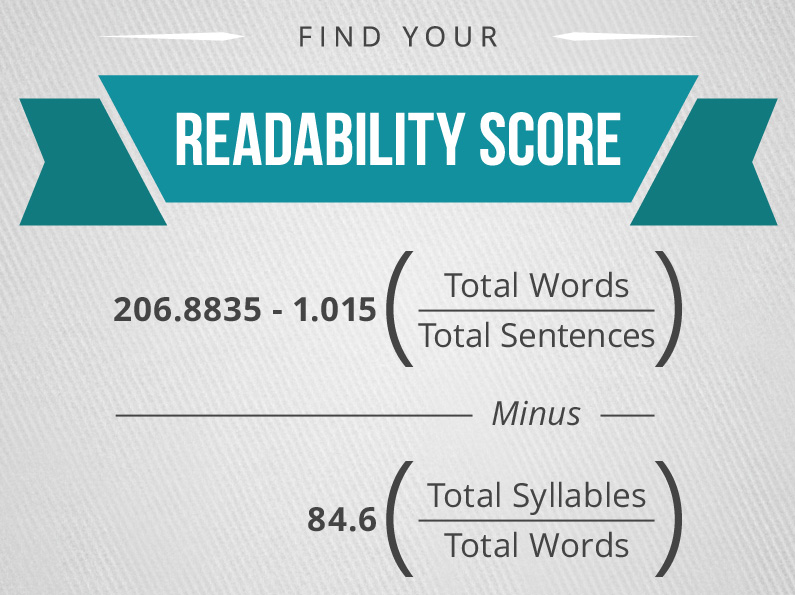
by Deanna Rivera | Jan 3, 2014 | Content Creation, Search Engine Optimization
If you are spending time writing a blog or a page for your website, you want to make sure that people actually read it and that you get the most out of it where search engines are concerned. With that in mind, please consider the following.
Readability
The math equation in the graphic below may have already sent you running scared from this blog. But if you want to know whether your blog will actually be read by most users of your website, pay attention. Luckily, if you have MS Word, you don’t have to do any math (look at the bottom of this blog for instructions.)
The math equation is called the Flesch-Kincaid Readability Score and it ensures you are writing in plain, understandable English. It’s important when writing for the web because psychologically speaking, people don’t want to do as much mental work reading your website as when reading a novel or newspaper.
In other words, keep it simple and they might stick around longer.
Readability Part 2
- Use white space, bullets, numbering, and good punctuation.
- Keep your sentences and paragraphs short.
- Use appropriate jargon. For instance, since ours is a technology related site, I could feel safe referring to search engine optimization or readability scores.
Search Engine Optimization
You really should leave Search Engine Optimization for the most part to your experts (hey, that’s us!) but when writing content, here are a few things anyone should do:
- Web crawlers can’t read images so tell them what the image is and include at least one keyword.
- Your title is the first thing the search engines read, so think about it and put a keyword or two in there, also.
- The same keywords in your picture and title should also be in your text.
For instance, for this article, my title keyword is website content and my image keyword is website readability. Hey look, those keywords are now in my blog a couple times. Yay me.
Figuring your Flesch-Kincaid Readability Score
Just in case the math equation still scares you and you don’t have MS Word, here’s a simple way to figure your score:
- Multiply the average sentence length by 1.015
- Multiply the average word length by 84.6
- Add the two numbers
- Subtract that total from 206.835
You want your score to be somewhere between 60-70 generally. 0-30 is WAY too high level for the average blog. 90-100 is probably too simplistic.
Here’s how you figure your score in MS Word:
- Go to Word Options
- Choose Proofing
- Ensure that the grammar with spelling box is checked
- Select the tick box for “Show readability statistics.”
Just in case you were wondering, the readability score of this blog is 66.3. Nailed it.
